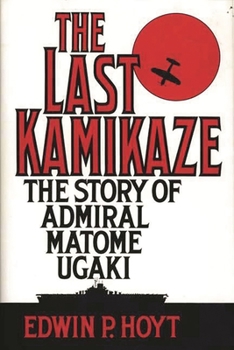Last Kamikaze: The Story of Admiral Matome Ugaki
Select Format
Select Condition 
Book Overview
This is the story of a man and a Navy--Vice Admiral Matome Ugaki and the Imperial Japanese Navy. By 1945 the Imperial Navy was physically destroyed and Admiral Ugaki was given the task of defending the Japanese homeland against attack, and he sent hundreds of kamikazes against the American naval forces operating around Okinawa. After Emperor Hirohito announced Japan's surrender on August 15, Ugaki stripped off his insignia of rank, climbed into...
Format:Hardcover
Language:English
ISBN:0275940675
ISBN13:9780275940676
Release Date:January 1993
Publisher:Praeger
Length:256 Pages
Weight:1.15 lbs.
Dimensions:1.0" x 5.8" x 8.9"
Customer Reviews
3 ratings
Kamikaze mania
Published by Thriftbooks.com User , 15 years ago
Written for the fan of WWII history, and more specifically of the war in the Pacific, this book is an excellent telling of the 1944-45 history of the Japanese Imperial Navy (and Army) kamikaze corps and one of its two prime movers, Admiral Ugaki. If you are interested in the kamikaze and the men behind the idea and the operations, this ones for you.
From the Japanese Perspective
Published by Thriftbooks.com User , 15 years ago
As another reader has noted, Edwin Hoyt's "The Last Kamikaze" reads as a condensed version of the life of Admiral Ugaki. While much of the story is said to be derived from the diary of Admiral Ugaki, the storytelling based on the diary seems impersonal with a level of disconnect. This may be a side-effect of the excerpts chosen by the author. While I did learn something from the book, I am not sure if it was necessarily derived from the perpective of the admiral or the other sources used to tell the story of the war. The name of the novel is derived from Admiral Ugaki's final act. His final act also seems to be the one part of the book where he is the key player. The bulk of each chapter, which seem all too brief, focuses on the Japanese war effort and the strategies employed. Though the admiral was a high ranking military official at times, he was not in a position to make decisions that focused the grand scheme of the war. Though these explanations give a perspective of the war effort, they take the focus away from Admiral Ugaki. Sections of the book give insight into the character of the admiral and make this book worth reading. Like a character in a novel, the progress toward the end, creates an unstoppable momentum in the story. Most Americans focus their attention on the other battlefront of World War II. If you are seeking to learn more about the Eastern Theater, this book is a good resource. On the other hand, this is a far from definitive look at Admiral Ugaki.
Condensed version of Admiral Ugaki's diary from WWII
Published by Thriftbooks.com User , 19 years ago
"Last Kamikaze" is like a Reader's Digest abridged version of the book "Fading Victory: The Diary of Admiral Matome Ugaki, 1941-1945". It is easy to read and has some additional historical background and commentary thrown in by the author to help understand some of Ugaki's thought processes. After reading this book, I went and found "Fading Victory" in the library. I am still trying to slug through that book - it's pretty dense going by comparison and makes me appreciate Hoyt's version much more. The only problem with condensed versions, of course, is that some of the details get lost, glossed over, or are over-generalized. This is a generic problem with Hoyt's writings, I have found. Nevertheless, this book is a good read. It really gives you a good sense of the thinking behind the intensely macho military culture run amok in Japan during WWII. The most important concept that I got out of this book was that this military culture was basically just like "Beavis and Butthead" in terms of their pathetic determination to engage in high testosterone acts of male stupidity and aggression, safe in a complete ignorance of how well the intended victims might be able to fight back. The parallels to this sort of teenage impulsiveness and short-sightedness continue with the (well-documented in this book) inability of the Japanese military to plan for the future or to anticipate potential pitfalls, after their inital success had faded. The only result of all this was a lot of death and suffering for the ordinary soldiers and civilians of Japan. A good example was the Guadalcanal campaign - the book describes in some detail how the Japanese Army first completely underestimated the capabilities of the American forces on Guadalcanal and repeatedly landed, piecemeal, undersized contingents of soldiers to drive off the Americans. Then, when these soldiers failed in their initial assaults, it turned out that the Japanese Army had made almost no plans for supplying these soldiers long term so that they could re-group and continue to fight. Large numbers of the Japanese soldiers starved to death or died of disease as a result. An initially small and tenuous American foothold on Guadalcanal grew ever stronger until Japan had to admit defeat and withdraw from Guadalcanal, giving the US its first major victory over Japan in a land conflict. Ugaki was among the contingent of hotheads who had sought to start the war with the US. After working with Admiral Yamamoto, (who was the only Japanese officer of any rank who had actually once lived in the US and so knew something about the country), he came to undertand how foolish that decision was. The level of American resources and economy was just far superior to Japan. Nevertheless, neither he nor the other militarists could bring themselves to admit that they had made a terrible mistake and give up the fight. Lots of foolish pride!!! At the moment of Japan's surrender, Ugaki's final act





